"Chile Peppers"
August 13, 2009 - Volume 1 - Issue 15
|
|
|
|
|
|
Special LeCreuset Feature
|
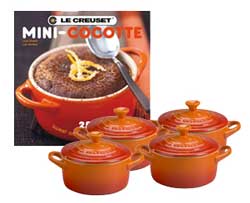 To
celebrate the heritage color, Flame, Le Creuset is offering this Limited Edition
Set of 4 Mini Cocottes in the iconic shade of orange. For a limited time,
purchase the Set of 4 Cocottes and receive a bonus cookbook dedicated to the
great features and benefits of the Mini Cocotte. Perfect for gift giving, this
set of 4 comes in a beautifully packaged hat box with
lid.
This brand
new cookbook from Le Creuset features 25 specially created recipes just for the
Mini Cocotte and its versatile cooking and serving features. Classic recipes
including French Onion Soup, Chicken Pot Pie and Macaroni and Cheese are
featured throughout the fully illustrated hard cover cookbook.
Set w/ cookbook: $80.00. While supplies last. |
|
|
|
Julie & Julia
|
 Julie & Julia Debuts Julie & Julia Debuts
Written by Columbia
Pictures.
Watch for
Le Creuset throughout the movie!
Bring in
your movie ticket stub from Julie and Julia and receive 10% off a Le Creuset
purchase of $50 or more! Not valid on promotional
items. |
Annual Sidewalk Sale - Sep 7th!
|
 |
Heating It Up!
|
|
|

|
|
Pepper pods are the fruit, (actually, botanically-speaking a "berry"), of Capsicum
plants. Purple, green, red, orange, and yellow, their bright colors are
eye candy in the vegetable world. Native and central to the Americas,
chile pepper plants circumnavigated the globe in the 1500's becoming a
staple in cuisines throughout Africa and Asia. Myth has it, that
Christopher Columbus assigned "pepper" to the chile pods likening its
heat to black pepper even though the two are not at all related.
Measuring the Heat
- Chile peppers are synonymous with culinary "heat." Understanding the
"heat factor" of chile peppers will provide you confidence in your
explorations and allow you to claim dynamite raves at the table.
Capsaicin, one of several heat-producing capsaicinoids in chiles, is
the substance most responsible for the spicy feel in our mouths.
Chile pepper heat is commonly measured in two ways:
Scoville Heat Units (SHU)
- Devised by William Scoville in 1912, the Scoville Organoleptic test
is a method of measuring chile pepper heat by diluting pepper extract
in water to the point that it is not discernable to the taste. The
higher the number, the greater the dilution, the hotter the pepper. By
definition, this method is subjective based on the taster's palate, but
it is directionally accurate when comparing the different varieties.
High-Performance Liquid Chromatography (HPLC) -
This method is the high-tech, laboratory technique for measuring the
chemicals responsible for the chile's heat. The capsaicinoids are
extracted from chile pods and processed through the chromatographer.
The chemical analysis accurately measures the chile's collective power
and the quantities of individual heat-producing chemicals.
Variations in Temperature
- Beyond the genetics of a chile, the environmental conditions in which
the chile grows can greatly impact an individual chile's warmth. This
helps to explain those situations where the same recipe may be just
right one time, and over the top with fire the next time. Birds appear
not to be sensitive to capsaicin and happily eat chile peppers spreading
their seeds efficiently. Men perceive chiles hotter than women -
something about testosterone . . . .
Advantages of Heat
- Consumed chiles connect with pain receptors in our mouth producing a
cascade of chemical reactions in our bodies. The pain receptors send
signals to our brain triggering an increased heart rate, more
perspiration, and a discharge of pain-relieving endomorphins. The
perspiration produces an evaporative cooling effect and the
endomorphins provide a natural feel-good. Besides their heat-related
qualities, chile peppers are nutritional goldmines - one chile pod has
the Vitamin C equivalent to six oranges! |
|
|
Preparing Peppers
|
Peppers are easily wrangled
in the kitchen with a little practice. These quick tips on technique will
shortcut your learning curve and your prep time!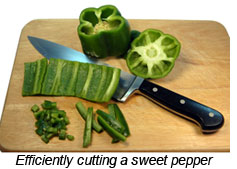
Cutting Bell Peppers - Achieving a dice or julienne of bell peppers happens quickly by
trimming the top stem end and the nubby bottom. Cut the pepper shell cylinder
open, trimming any seeds and membrane away. Some of us like to wash the pepper
at this stage finding it easy to remove any outside dirt and loose seeds all at
once instead of in two washings. Spread the pepper flat. Using your best
cutting form, cut strips from the pepper "sheet." To dice, turn the strips
perpendicularly and slice away!
Scraping out Seeds - The membranes and seeds in chile peppers hold concentrated heat. Most
preparations of fresh chile peppers require removal of these "innards."
Depending on the pepper, a knife may do the job very well. For other peppers,
especially small ones, try using a melon baller, a grapefruit spoon, or even a
demitasse spoon. The curved shapes match the pepper's form nicely.
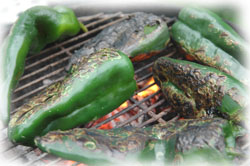 Roasting Peppers - The outer skin of a chile pepper can be tough and undesirable. It's
such a thin layer that peeling a pepper as you would an apple is impossible.
The time-honored method of removing this outer membrane is through roasting the
pepper. Roast a pepper by applying high heat to the outer surface. The heat
blisters the skin making it easy to remove. In the process, the skin may become
quite blackened; inside the pepper's flesh remains firm and succulent. Roasting Peppers - The outer skin of a chile pepper can be tough and undesirable. It's
such a thin layer that peeling a pepper as you would an apple is impossible.
The time-honored method of removing this outer membrane is through roasting the
pepper. Roast a pepper by applying high heat to the outer surface. The heat
blisters the skin making it easy to remove. In the process, the skin may become
quite blackened; inside the pepper's flesh remains firm and succulent.
Fire
Roasting - This most common
method can be accomplished on the grill, over a gas stovetop burner, or with a
culinary torch. Place the fresh peppers directly over the fire 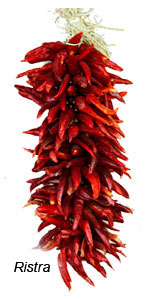 turning them
frequently to allow all sides to be reached by the flames. Over a strong flame,
Jalapeño peppers will take 3-4 minutes, the larger Anaheim or Poblano
peppers will take 5-6 minutes. Watch and tend the peppers closely. turning them
frequently to allow all sides to be reached by the flames. Over a strong flame,
Jalapeño peppers will take 3-4 minutes, the larger Anaheim or Poblano
peppers will take 5-6 minutes. Watch and tend the peppers closely.
Heat
Roasting - This method can be
accomplished in the oven (400-450° F), or with a grid
pan on top of an electric burner. Turn the peppers frequently during the
heating.
When the skin has blistered
uniformly, remove from heat and place in a brown paper bag or closed container
for a few minutes. Steam will collect and serve to further loosen the chile's
skin. After this step, the outer skin can be removed quickly by gently pulling
the skin away from the pepper.
Drying Peppers
- A familiar site and fragrance this time of year in the Southwest are the ristras
- chiles strung together hanging in the sun to dry. These classic forms are
made from red, ripe chiles. To learn how to make your own ristras, consult this
"How-To" page
from New Mexico State University.
|
Smart Chile Pepper Tips
|
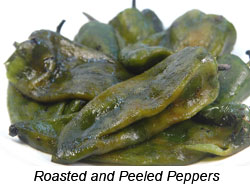 Tip #1: When roasting peppers, make the most of your
effort by doing a few extra and freezing them in a single layer. You may peel
before or after freezing. Tip #1: When roasting peppers, make the most of your
effort by doing a few extra and freezing them in a single layer. You may peel
before or after freezing.
Tip #2: Chipotles in adobo sauce are red, ripe jalapeño chiles that have been dried, smoked and canned in a
vinegary tomato sauce. We find that one small can provides enough chile power
for several recipes. Once the can is open, chop the entire contents and freeze
the unused portion in handy tablespoon quantities for future use.
Tip #3: Confused
by the chile terminology? Fresh chiles have one name, dried they have another.
Here's a translation of some of the more commonly used chile terms: Poblano (fresh) = Ancho
(dried), Jalapeño (fresh) = Chipotle (smoked-dried red), Mirasol (fresh)
= Guajillo (dried), Green Chile (fresh) = Pasado (dried).
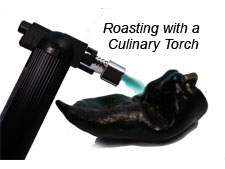 Tip #4: Generally,
the smaller the pepper, the hotter. Peppers become hotter as they ripen with
red peppers two to three times hotter than their green precursors. Hotness
concentrates even further when dried. The hottest pepper on record according to
the Guinness Book of World Records is the Bhut Jolokia with its Scoville score
of 1,001,304! Tip #4: Generally,
the smaller the pepper, the hotter. Peppers become hotter as they ripen with
red peppers two to three times hotter than their green precursors. Hotness
concentrates even further when dried. The hottest pepper on record according to
the Guinness Book of World Records is the Bhut Jolokia with its Scoville score
of 1,001,304!
Tip #5: Chiles
roasted directly over a flame will wilt the flesh slightly. Chiles roasted in the oven will
yield slightly firmer flesh, and chiles torched with a culinary torch will
result in the firmest (least cooked) flesh.
|
Q & A's
|
 Q: What's the best way to protect your skin when
preparing peppers? Q: What's the best way to protect your skin when
preparing peppers?
A: The capsaicin in chiles can be irritating to
your skin. A coating on your fingers with olive oil may provide a layer of
protection. Wash your hands well with soap after handling chiles. 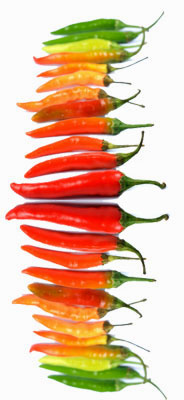 Some report that
cleaning up with a wipe down with rubbing alcohol will dissolve the potent chile
oils. Gloves are helpful when working with chiles. Do not touch your eyes when
working with chiles. Some report that
cleaning up with a wipe down with rubbing alcohol will dissolve the potent chile
oils. Gloves are helpful when working with chiles. Do not touch your eyes when
working with chiles.
Q: What's the best antidote for chile heat?
A: Chile heat comes from chemicals
that are hydrophobic, that is, they do not combine well with water. That's why
drinking water (or beer) will not quell the heat in your mouth or throat. Instead,
try a dairy product, bread, or rice to tame the flame.
Q: What is Tabasco® sauce?
A: Inspired in 1868 by the tabasco pepper plant,
the McIlhenny family made this hot chile into a sauce business located on Avery
Island, Louisiana. Crushed chiles, salt, white wine vinegar and 3 years of
aging in white oak barrels produce one of the most familiar chile-based hot sauces.
Q: What is the hottest part of a chile?
A: The capsaicin is concentrated in the seeds,
membrane and stem end of a chile. Remove the inner seeds and white membranes as
part of your preparation of fresh chiles.
Q: What's the difference between green and red
chiles?
A: One might think the two common colors are two
different species or varieties, however, green is just the immature form of the
pepper. Red indicates a ripe chile. Both immature and ripe chiles are used extensively
each lending a particular character to a dish.
|
Cookbook Review
|
The Great Chiles Rellenos Book by Janos Wilder. Copyright 2008. Published by Ten
Speed Press, Berkeley, CA. (The book may be ordered from the publisher by calling 1-800-733-3000 or by going to www.tenspeed.com).
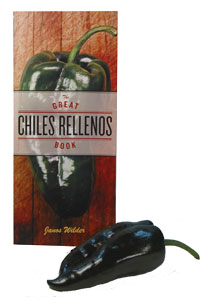 Cookbooks that take a single
food and riff on it are fascinating! With a singular focus, mastery of the
topic seems accessible for the everyday cook. This is the case with the
cookbook, The Great Chiles Rellenos Book. The term, chile rellenos,
translates to "peppers, stuffed." As the author explains, he began stuffing Anaheim, Poblano and
Jalapeño peppers with traditional recipes from different
regions, and then veered off into the land of experimentation. The cookbook
logically sets a solid foundation with a helpful discussion of roasting and
preparing peppers. The fillings range, as promised, from traditional cheese to
exotic lobster with triple cream brie, and everything in between. A chapter is
also included for peppers in casseroles, salads, and as "poppers." The sauces
and condiments that will complement the chile rellenos are graciously included
and polish the presentation to a delightful finish. We appreciated the in-depth
lessons on chile rellenos and feel quite enabled in turning a couple of these
recipes into new personal signature dishes! Cookbooks that take a single
food and riff on it are fascinating! With a singular focus, mastery of the
topic seems accessible for the everyday cook. This is the case with the
cookbook, The Great Chiles Rellenos Book. The term, chile rellenos,
translates to "peppers, stuffed." As the author explains, he began stuffing Anaheim, Poblano and
Jalapeño peppers with traditional recipes from different
regions, and then veered off into the land of experimentation. The cookbook
logically sets a solid foundation with a helpful discussion of roasting and
preparing peppers. The fillings range, as promised, from traditional cheese to
exotic lobster with triple cream brie, and everything in between. A chapter is
also included for peppers in casseroles, salads, and as "poppers." The sauces
and condiments that will complement the chile rellenos are graciously included
and polish the presentation to a delightful finish. We appreciated the in-depth
lessons on chile rellenos and feel quite enabled in turning a couple of these
recipes into new personal signature dishes!
|
Recipes featuring Chile Peppers
|
Reprinted with permission
from The Great Chiles Rellenos Book by Janos Wilder,
copyright © 2008. Interior photo credit: Laurie Smith © 2008; Cover photo
credit: Ed Anderson © 2008. Published by Ten Speed Press, an imprint of the
Crown Publishing Group, a division of Random House, Inc., New York. The book may be ordered from the publisher by calling 1-800-733-3000 or by going to www.tenspeed.com.
Basic Monterey Jack
Cheese Chiles
Rellenos
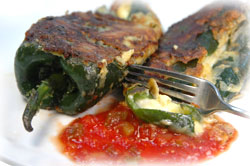 This introductory recipe is
perfect for getting started with chiles rellenos. The preparation provides
experience with roasting peppers, stuffing, and light breading processes. Sautéed,
not deep-fried, these stuffed peppers were easy and delicious! Topped with a
bit of salsa, two per person made for a perfect supper! This introductory recipe is
perfect for getting started with chiles rellenos. The preparation provides
experience with roasting peppers, stuffing, and light breading processes. Sautéed,
not deep-fried, these stuffed peppers were easy and delicious! Topped with a
bit of salsa, two per person made for a perfect supper!
Click here to
view the illustrated recipe.
Click here for a printable version of
the recipe.
Culichi and Shredded Chicken Chiles Rellenos
Casserole
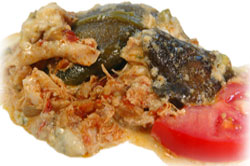 Layered in lasagna fashion, the
roasted peppers provided one layer, the shredded chicken in a diced onion and
tomato sauce provided the next layer. Monterey Jack cheese came next, and a
fantastic Mexican white sauce, Culichi, finished the dish. The result was an
incredibly delicious casserole that baked into a hearty, delicious meal. Layered in lasagna fashion, the
roasted peppers provided one layer, the shredded chicken in a diced onion and
tomato sauce provided the next layer. Monterey Jack cheese came next, and a
fantastic Mexican white sauce, Culichi, finished the dish. The result was an
incredibly delicious casserole that baked into a hearty, delicious meal.
Click here to view the illustrated recipe.
Click here for a printable version of
the recipe.
Cheddar, Sun-Dried Tomato, and Chorizo Poppers in
Tortilla Crust
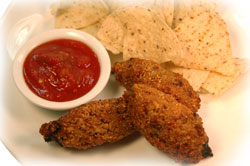 While jalapeños lose a lot of their heat when heated, there's still
just enough punch to live up to their reputation. These poppers avoid the
over-used cream cheese filling. Instead, the stuffing for these poppers is a
magic mixture of chorizio, sun-dried tomatoes and cheddar cheese - a great
combination for nachos if there's any leftover stuffing. The ground tortilla
chip breading completed the complementary flavors. This recipe gives "poppers"
a whole new dimension! While jalapeños lose a lot of their heat when heated, there's still
just enough punch to live up to their reputation. These poppers avoid the
over-used cream cheese filling. Instead, the stuffing for these poppers is a
magic mixture of chorizio, sun-dried tomatoes and cheddar cheese - a great
combination for nachos if there's any leftover stuffing. The ground tortilla
chip breading completed the complementary flavors. This recipe gives "poppers"
a whole new dimension!
Click here to view the illustrated recipe.
Click here for a printable version of
the recipe.
|
 |
Warm up the table with some chile heat!
|
|
Lorraine, Katie, and all of the Staff at Beyond Pots and Pans
|
|
|
|
|